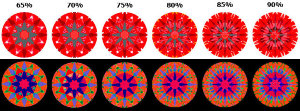I posted about this a few days ago but looking for other thoughts as well.
This weekend I am going to look at a few diamonds at Tiffany and my 2 leading contenders based on size I want and specs are this 60/60 stone and another with more "ideal" ratios. They both are under 2 on HCA and I know I will have to see them in person but based on the specs, would you lean towards one over the other assuming they both look as good as each other in person?
Diamond 1:
This is a 1.13 IVS2
Diamond dimensions are 6.73 X 6.75 X 4.06 Table 60.2%, depth 60%, crown height 13.6%, crown angle 33.9, Pavilion 43%
Diamond 2:
1.10 IVS2
6.60 X 6.63 X 4.07
D 61.5%, T 57%, CH 15.1%, CA 34.8, P 40.7
Thanks!
This weekend I am going to look at a few diamonds at Tiffany and my 2 leading contenders based on size I want and specs are this 60/60 stone and another with more "ideal" ratios. They both are under 2 on HCA and I know I will have to see them in person but based on the specs, would you lean towards one over the other assuming they both look as good as each other in person?
Diamond 1:
This is a 1.13 IVS2
Diamond dimensions are 6.73 X 6.75 X 4.06 Table 60.2%, depth 60%, crown height 13.6%, crown angle 33.9, Pavilion 43%
Diamond 2:
1.10 IVS2
6.60 X 6.63 X 4.07
D 61.5%, T 57%, CH 15.1%, CA 34.8, P 40.7
Thanks!





300x240.png)